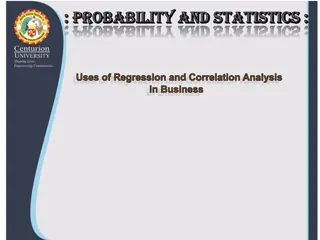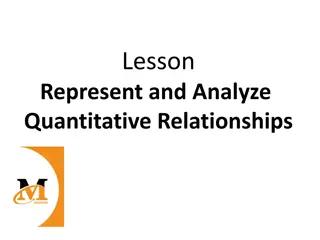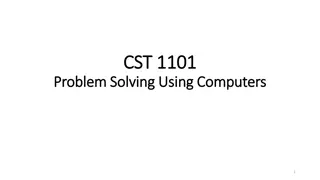Exploring Data Relationships and Variables in Everyday Life
Discover the importance of data in decision-making, interpretation, and answering questions through examples of one-variable and two-variable data sets. Learn about independent and dependent variables, and how to graph data to visually represent relationships. Dive into real-world examples like species diversity on islands to understand the dynamics between variables.
Download Presentation

Please find below an Image/Link to download the presentation.
The content on the website is provided AS IS for your information and personal use only. It may not be sold, licensed, or shared on other websites without obtaining consent from the author. Download presentation by click this link. If you encounter any issues during the download, it is possible that the publisher has removed the file from their server.
E N D
Presentation Transcript
Chapter 1 Data Everywhere
Data Everywhere All slides in this presentations are based on the book Functions, Data and Models, S.P. Gordon and F. S Gordon ISBN 978-0-88385-767-0 We are surrounded in everyday life by different data. Here are some important questions regarding data. 1. How to make decisions based on data? 2. How to interpret data? 3. How to use data to answer various questions? One variable data; two-variable data; data on more than 2 variables p. 2
Two-Variable Data Independent/Dependent Variables Scale
Two Variable Examples In many situations we have data that involve 2 different quantities/variables a) Education level and salary of employees b) Height and weight of people c) Size of a land/habitat and number of distinct species who live there p. 4
Example of Two Variable Data Ex. Number of reptiles and amphibians living on different islands in the Caribbean Sea and the area of these islands in sq. miles Two variables lets give them names N - number of species A - area One of them depends on the other What do you suggest? p. 5
Independent/Dependent Variables We have two quantities/variables; one depends on the other One is the independent variable, the other is the dependent variable Which is the independent variable? How about the dependent variable? Why? p. 6
Independent/Dependent Variables N (number of species) is the dependent variable and A (area of the island) is the independent variable The independent variable is graphed horizontally and the dependent variable - vertically p. 7
Graphing the data - Scale The number of species N extends vertically from 3 to 84 The area A extends horizontally from 1 to 44,218 sq. miles 1.From 0 to 90 with tick marks every 10 species 1.From 0 to 45,000 sq. miles with tick marks every 15,000 sq. miles 2.From 0 to 100 with tick marks every 20 species 2.From 0 to 45,000 sq. miles with tick marks every 9,000 sq. miles 3.From 0 to 100 with tick marks every 10 species 3.From 0 to 50,000 sq. miles with tick marks every every 5,000 sq. miles p. 8
Scatter Plots Def - a graph in which the values of two variables are plotted along two axes, the pattern of the resulting points revealing any correlation present. Island Saba is represented by the point (A, N) = (4, 5) Jamaica by (A, N) = (4 411, 39) Cuba by (A, N) = (44 218, 76) p. 9
Scatter Plots - Example Continued As the Area of the island increases, the Number of species who live on the island also increases N grows more and more slowly as A increases Want to answer predictive questions, e.g. Area of Barbados is 166 sq. miles; estimate the number of species that live there Estimate the size of a habitat that will support 25 species of reptiles and amphibians p. 10
US population between 1780 and 1900 Which is the independent/dependent variable? What scale of the scatter is good to be used? State what each variable you use stands for in reality Draw the scatterplot What predictive questions can be answered later once we get a formula? p. 11
Predictive Questions What would the population of the U.S. have been in 1920? What was the population in 1875? When would the U.S. population have reached 100 million? p. 13
Independent/Dependent Variable Examples In a study to determine whether how long a student sleeps affects test scores; what is the independent variable and what is the dependent variable? The independent variable is the length of time spent sleeping while the dependent variable is the test score. p. 14
Independent/Dependent Variable Examples If you want to know whether caffeine affects your appetite, what is the independent variable and what is the dependent variable? the presence/absence of the amount of caffeine would be the independent variable. How hungry you are would be the dependent variable. p. 15
Independent/Dependent Variable Examples You want to compare different brands of paper towels, to see which holds the most liquid. What is the independent variable and what is the dependent variable? The independent variable in your experiment would be the brand of paper towel. The dependent variable would be the amount of liquid absorbed by a paper towel. p. 16
Example Temperature readings were recorded every two hours from midnight to 2:00 P.M. in Dallas on June 5, 2017. The time was measured in hours from midnight. time Temperature 0 2 4 6 8 10 81 12 88 14 91 73 73 70 69 72 a. Decide which is the independent variable and which is the dependent variable. b. Decide on the appropriate scales for the two variables for a scatterplot. c. What letter will you use for each variable? d. Draw the scatterplot. p. 17
Solution Temperature readings were recorded every two hours from midnight to 2:00 P.M. in Dallas on June 5, 2017. The time was measured in hours from midnight. time Temperature 0 2 4 6 8 10 81 12 88 14 91 73 73 70 69 72 Decide which is the independent variable and which is the dependent variable. The Independent variable is time and the dependent variable is Temperature a. Decide on the appropriate scales for the two variables for a scatterplot. The time scale: 0 16 increments of 2 and the Temperature scale: 65 95 increments of 5 b. What letter will you use for each variable? We might use t for time and T for Temperature. c. Draw the scatterplot. (next page) d. p. 18
Solution Dallas Weather 95 90 85 Temperature 80 75 70 65 0 2 4 6 8 10 12 14 16 time p. 19























